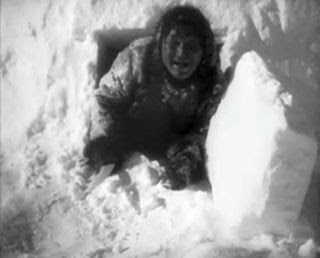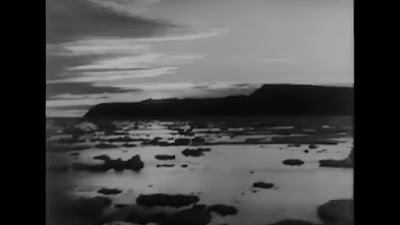Nanook of the North (1922) Starring Allakariallak, Nyla, Cunayou. Directed by Robert J. Flaherty. Written by Robert J. Flaherty. Produced by Robert J. Flaherty. Run time: 79 minutes. USA. Black and White. Silent. Documentary.
The very earliest films, produced by the Lumière Brothers were
what are known as "Actualités", short pictures of real people in real
places. The first of these films was La sortie des usines Lumière (Workers
Leaving the Lumière Factory), (1895), was also the first film exhibited by
the Lumières on December 28, 1895. These sorts of films were the precursors to
what would become documentary films.
While not the first documentary, Nanook of the North by
Robert J. Flaherty was the first full length documentary to achieve commercial
success. As such, it would show the financial viability of the genre and would
inspire other filmmakers and films to come.
This was not Flaherty’s first attempt to make a film about Eskimo life. Between 1913 and 1914, Flaherty apprenticed as a cameraman as part of five Sir William Mackenzie expeditions that explored Canada’s North Hudson Bay region. During these expeditions, Flaherty shot 30,000 feet of what he referred to as amateurish negative. However, during the editing process, Flaherty dropped a cigarette onto the original camera negative (which was highly flammable nitrate stock) and all of it was destroyed.
However, seeing the value of such a picture, Flaherty and his funder, Revillon Freres, a fur-trading company, prepared for a more elaborate reshoot. With a $53,000 budget, a fully-outfitted expedition embarked in 1920 to begin production in Cape Dufferin. They had with them the equipment necessary to develop the film as it was shot, which Flaherty in the preface of the film states that allowed him to show the film to the Eskimos he was filming.
 |
| Nanook, Nyla and Robert J. Flaherty on location. |
The film was shot over two winters and two summers, and was acquired by Pathe for worldwide distribution. It was first released on June 11, 1922. At the time of its release, the film was hailed as a “masterpiece” by Photodramatist. Flaherty would use his new notoriety as a documentarian to turn his lens to other societies, Moana (1926), and Man of Aran (1934), before turning to fiction films like Elephant Boy (1937), and Louisiana Story (1948). He would also make several short-form documentaries like The Pottery Maker (1925) and Twenty-Four-Dollar Island (1927).
 |
| Learning the old ways of bow and arrow. |
The documentary supposedly follows the lives of an Inuk, Nanook (The Polar Bear), and his family as they travel, search for food, and trade in the Ungava Peninsula of northern Quebec, Canada. Nanook, his wife Nyla and their family are introduced as fearless heroes who endure rigors no other race could survive. The audience sees Nanook, often with his family, hunt a walrus, build an igloo, go about his day, and perform other tasks. All set against a vast white wasteland.
But it turns out the film was more dramatization than
documentary.
 |
| Nanook’s real name was Allakariallak. |
To begin with, Nanook’s real name was Allakariallak. Flaherty apparently chose this nickname because it was more marketable to Euro-American audiences. And his two wives Nyla and Cunayou were actually Flaherty’s common-law wives. Nyla, whose real name was Maggie Nujarlutuk, bore Flaherty a son named Josephie, whom Flaherty never met. Josephie was eventually adopted by Paddy Aqiatusuk, a renowned soapstone sculptor who married Maggie. Little is known about Cunayou.
 |
| Nyla "The Smiling One" was played by Maggie Nujarlutuk. |
The film opens with Flaherty bringing his wife and family to the “Trade Post of the White Man.” They arrive in a kayak and one by one are offloaded in what was the Eskimo of the circus clown car. In an attempt to show the humor in the two cultures coming together, the white trader is shown playing a gramophone for Nanook, explaining how a man 'cans' his voice. Nanook is supposedly amazed at the invention and even tries to bite the shellac disc. In actuality, Allakariallak knew what a gramophone was and the scene was scripted and played for laughs at the naivete of Nanook and people isolated from Western culture.
.jpg) |
| Played for laughs, Nanook tries to bite a record. |
While on a hunting trip, one of the film's most celebrated scenes takes place when Nanook builds an igloo from snow and ice in under an hour. We see Nanook and his family coping with life inside the igloo. However, in order to make an igloo large enough to get a camera inside proved problematic. The igloo either collapsed under its own weight or was too dark to photograph inside. They ended up filming in a three-walled igloo which allowed for enough light to enter.
 |
| Nanook builds an igloo and Flaherty takes us inside. |
Flaherty later would relate the following story in the 1950 article “Robert Flaherty Talking," in Cinema magazine, “The average Eskimo igloo, about 12 feet in diameter, was much too small. On the dimensions I laid out for him, a diameter of 25 feet, Nanook and his companions started in to build the biggest igloo of their lives. For two days they worked, the women and children helping them. Then came the hard part - to cut insets for the five large slab-ice windows without weakening the dome. They had hardly begun when the dome fell in pieces to the ground. 'Never mind,' said Nanook, I can do it next time.' For two days more they worked, but again with the same result; as soon as they began setting in the ice windows their structure fell to the ground. It was a huge joke by this time, and holding their sides they laughed their misfortune away. Again, Nanook began on the 'big Aggie igloo', but this time the women and children hauled barrels of water on sledges from the water-hole and iced the walls as they went up. Finally, the igloo was finished and they stood eyeing it as satisfied as so many small children over a house of blocks. The light from the ice-windows proved inadequate, however, and when the interiors were finally filmed the dome's half just over the camera had to be cut away, so Nanook and his family went to sleep and awakened with all the cold of out-of-doors pouring in."
 |
| In reality, a special 3/4 igloo was built to allow for interior filming. |
By the time Flaherty began filming Inuit life it had become more westernized. By the 1920s, they were integrating the use of Western clothing and were using rifles to hunt rather than harpoons. But Flaherty insisted they use harpoons when they went hunting a walrus. Some critics, like Robert Ebert, would give Flaherty a pass. “The film is not technically sophisticated; how could it be, with one camera, no lights, freezing cold, and everyone equally at the mercy of nature? But it has an authenticity that prevails over any complaints that some of the sequences were staged. If you stage a walrus hunt, it still involves hunting a walrus, and the walrus hasn't seen the script. What shines through is the humanity and optimism of the Inuit.”
It is no doubt that the life of the Inuit was harsh, however, it was not as dire as Flaherty depicted, with them often approaching starvation before any food is found. In perhaps the most egregious of the lies, in his preface, Flaherty states that Nanook had died of starvation while on a deer hunt. However, Allakariallak actually died at home, likely of tuberculosis.
Many of Flaherty’s practices would not fly today and what he
did do, in retrospect, comes off as a feature-length reality TV show. While he
wanted to show Inuit life, he showed them as more primitive than they really
were. That may have made the film more interesting for its intended audiences,
it does not present a true picture of what was actually going on. No doubt that
living in the Arctic is hard but Flaherty makes them seem a little too
primitive and plays the near-starvation card a little too hard. By staging
events, like Nanook trying to eat the record, for the camera, he presents them
as more naïve than they were. Were audiences supposed to admire the Inuits in
their great struggle to survive and also pity them for being so backward?
 |
| With climate change, scenes like this, of ice flows in the ocean might someday be a thing of the past. |
One thing the film might have inadvertently done well was to document the conditions that the Inuits lived in what the Arctic was like a hundred years ago. With climate change scenes like the ice flows in the water might vanish over time.
The biggest problem with Nanook of the North is that the film is rather boring, especially to modern audiences. There is really very little action of note in the film. Arriving at a Trading Post might have more bite if it truly was native meet modern, rather than a staged encounter. The hunt for the walrus ends with the walrus dead all right but the hunt ends up being more of a tug of war than a man vs. Beast cage match for survival.
That is not to say that it is not interesting to see how others live but was this really how they were living when Flaherty visited or was it rather how he wanted you to think they lived? While many documentaries try to get a certain point of view across, they should try to be less invasive to the story they’re filming. Flaherty may have made a “masterpiece” by 1922 standards but a hundred years later that film comes off as more exploitation than fact and sadly, boring to watch. Our standards for documentaries and for entertainment have changed in the last 100 years, leaving Nanook of the North out in the cold.


No comments:
Post a Comment